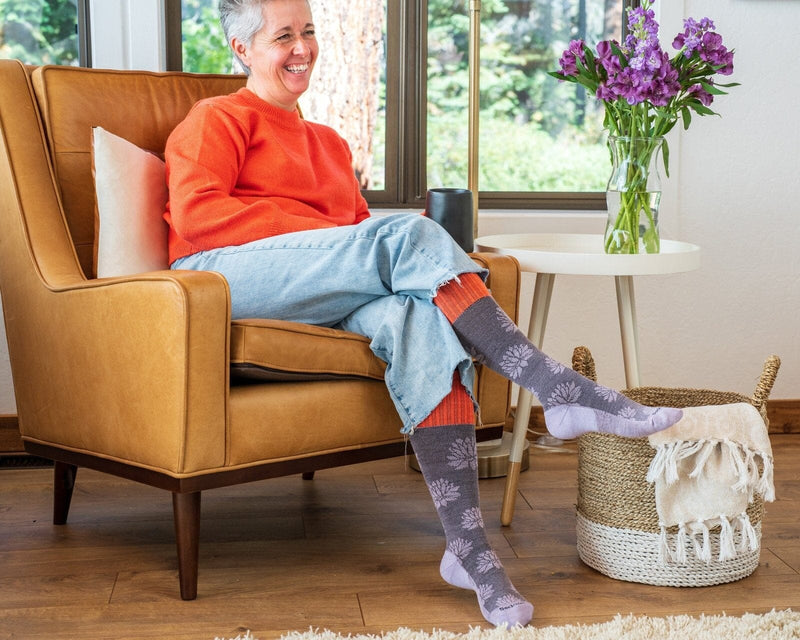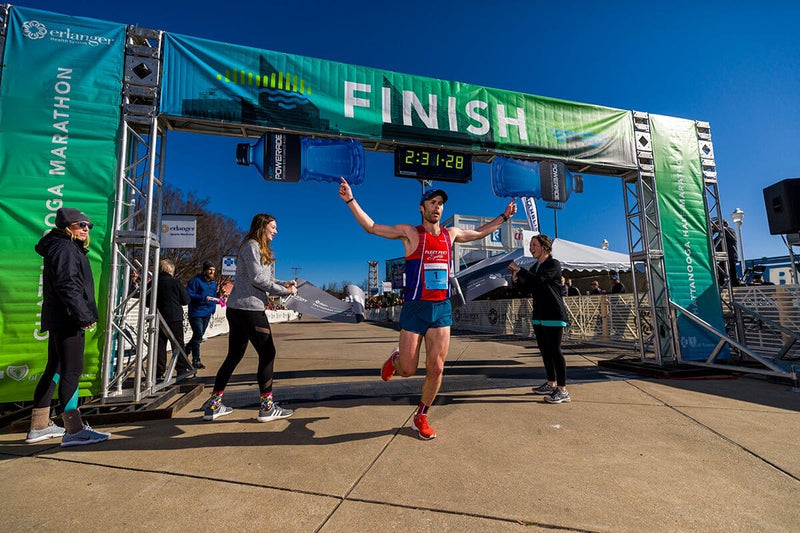
Dealing with varicose veins can feel like a never-ending battle, right? Those bulging, twisted veins aren't just unsightly—they can also be downright uncomfortable. Luckily, there's a simple solution that can make a world of difference: compression socks.
Key Takeaways
-
Varicose veins are swollen, enlarged veins caused by malfunctioning valves that allow blood to pool, often influenced by genetics, age, lifestyle, pregnancy, and obesity.
-
Compression socks help improve blood flow by applying graduated pressure, which pushes blood back toward the heart and relaxes the arteries.
-
The best compression socks for varicose veins, like graduated options, effectively manage symptoms by applying targeted pressure from ankle to calf, improving circulation and reducing discomfort, available in various compression levels for different needs and materials for durability and comfort.
-
Different compression levels (measured in mmHg) serve various needs, from mild daily discomfort to severe venous diseases. Thigh-high and knee-high options cater to different preferences and conditions.
-
Seek medical advice for severe symptoms, persistent leg cramps, pregnancy-related varicose veins, the development of sores, or any new symptoms to ensure appropriate treatment.
Understanding Varicose Veins
People often find varicose veins unsightly, and they can be quite a nuisance. Imagine your leg veins looking like road maps that all lead to discomfort city. Let's look into what varicose veins are and why they insist on making a home in your legs.
What Are Varicose Veins?
Think of varicose veins as veins that go on a permanent vacation and forget to do their job. Typically, these veins are swollen, enlarged, and twisty like an overcooked spaghetti noodle. Veins have valves that act like gatekeepers, ensuring blood moves back toward your heart. When these valves decide to take a nap, blood pools in the veins, making them varicose.
What Causes Varicose Veins?
Varicose veins are enlarged, twisted veins often appearing on the legs. They occur when faulty vein valves allow blood to pool, causing increased pressure. Key factors contributing to varicose veins include:
-
Genetics: Family history increases your risk.
-
Age: As we age, vein elasticity decreases.
-
Lifestyle: Prolonged standing or sitting, and lack of exercise contribute.
-
Pregnancy: Hormonal changes and increased blood volume impact vein health.
-
Weight: Excess weight puts extra pressure on veins.
To prevent or manage varicose veins, consider regular exercise, maintaining a healthy weight, and using compression socks.
How Compression Socks Work
Compression socks love your legs! They aren't just everyday socks; they're designed to improve blood flow and give those veins a little TLC.
Increasing Blood Flow
Do you feel like your legs need a boost? Compression socks promote circulation by gently squeezing your legs. They’re tighter around the ankle and loosen as they go up. This pressure pushes blood up towards your heart, helping to reduce blood pooling and clotting. It's like giving your veins a helpful nudge, saying "Keep moving, you can do it!"
Relaxing Arteries
Who wouldn't want relaxed arteries? When you wear compression socks, they promote relaxation in your arteries, improving blood flow to your muscles. Imagine your arteries sighing in relief, thinking, "Ah, this feels good."
Best Compression Socks For Varicose Veins
Varicose veins aren't just an eyesore; they're a literal pain. But don’t worry, compression socks are here to save the day! Let’s explore the best options.
Graduated Compression Socks
Graduated compression socks are highly effective for managing varicose veins by applying the most pressure at the ankles and gradually decreasing it up the leg. This enhances blood flow and reduces discomfort and varicose veins' appearance. They come in various compression levels (measured in mmHg), with 15-20 mmHg for mild cases and higher levels for severe cases, as advised by a healthcare professional.
When choosing these socks, consider materials like nylon, spandex, Merino Wool, and microfiber for durability and comfort, and ensure a proper fit by measuring the ankle, calf, and sometimes thigh. Modern graduated compression socks also come in various styles and colors, combining medical benefits with aesthetic appeal.
1. Elevation Graduated Compression Socks
Elevation Graduated Compression Socks are designed to prevent and manage varicose veins by applying targeted pressure to the legs. These socks improve blood circulation, reducing swelling and discomfort, and are available in various compression levels to suit individual needs. By mimicking the action of calf muscles, they help prevent blood pooling and alleviate symptoms like leg heaviness and fatigue, making them a valuable tool for those at risk or experiencing varicose veins.
2. Circulator Graduated Compression Socks
Circulator Graduated Compression Socks are designed to alleviate varicose veins by improving blood circulation and reducing swelling. With graduated pressure applied from the ankle upwards, these socks effectively combat blood pooling. Made from breathable and durable materials such as nylon, spandex, and Merino Wool, they offer comfort and support for both daily wear and active lifestyles, making them a popular choice for individuals managing varicose veins.
3. Micro Grade Graduated Compression Socks
When dealing with varicose veins, finding the right compression socks can be a game-changer. Among the various types available, Micro Grade Graduated Compression Socks stand out as an exceptional choice for both effectiveness and comfort. These socks are specially designed to offer varying degrees of pressure, which can significantly enhance blood circulation and reduce the discomfort associated with varicose veins.
The “micro grade” designation refers to the fine granularity of the pressure levels, allowing for a more precise fit and more effective compression therapy. This specificity can make these socks more comfortable for all-day wear, as they adapt better to the natural shape and contour of your legs.
Who knew a pair of socks could do so much? Whether you’re battling mild annoyances or severe venous conditions, there’s a pair out there ready to take on the challenge with you.
Choosing The Right Compression Socks
You've already got the lowdown on how compression socks help with varicose veins. Now, let's dive into choosing the right pair!
Compression Levels and Their Uses
Compression socks come with different pressure levels, measured in mmHg. For varicose veins, look for moderate compression (15-20 mmHg). This level promotes better circulation and helps manage mild to moderate swelling. Think of it as giving your legs a gentle yet firm hug. Higher levels, like 20-30 mmHg or 30-40 mmHg, are for more serious cases or as prescribed by your doctor. Keep it simple—start at 15-20 mmHg unless told otherwise.
Styles of Compression Socks
Finding the perfect style can feel like picking out a new pair of shoes. Knee-high socks are versatile and fit seamlessly into your everyday routine. If you've got more extensive swelling or venous insufficiency, thigh-high socks offer full-leg coverage. Feel like flaunting your pedicure? Open-toe styles are your go-to. They're comfy and practical, especially for warmer weather. Plus, they make it easier to pair with your favorite sandals.
When To Consult A Doctor
It's crucial to know when to consult a doctor about varicose veins and your use of compression socks. While these socks work wonders by promoting circulation and alleviating symptoms, certain situations call for professional advice.
Severe Symptoms
Notice severe pain, swelling that won’t quit, or skin changes around your varicose veins? Time to see your healthcare provider. Persistent symptoms might need more intensive treatment or indicate underlying conditions that compression socks alone can't solve.
Frequent Leg Cramping
Getting leg cramps more often than you'd like? Especially if they’re interfering with your beauty sleep? A doctor's visit can help determine if there’s more at play than just varicose veins.
Pregnancy-Related Varicose Veins
Pregnancy leads to many changes, including our lovely varicose veins. If your veins become painful or severely swollen during pregnancy, speak with your OB-GYN. They might suggest additional or alternative treatments.
Sores or Ulcers
Any sores or ulcers around your varicose veins need immediate medical attention. These can be signs of more serious issues that strictly require a doctor's expertise.
New Symptoms
Notice new symptoms or the worsening of old ones? Always a good idea to check in with your healthcare provider. They can help adjust your treatment plan and ensure your health is on point.
Trust that your healthcare provider will steer you in the right direction when your symptoms take a turn. After all, they’re the experts, and you deserve the best care possible.
In A Nutshell
Picking the right compression socks is key to managing varicose veins effectively. By understanding how compression works and selecting the appropriate level and style for your condition, you can significantly improve your comfort and well-being. Remember, for severe symptoms, always consult a healthcare professional. With the right socks, you can enjoy increased circulation, reduced swelling, and a boost in energy throughout your day.
Discover the transformative power of Sockwell compression socks. Crafted with premium Merino Wool, our socks offer unparalleled comfort and support. Experience reduced swelling, improved circulation, and effective varicose vein management. Elevate your comfort and well-being today. Shop now!



